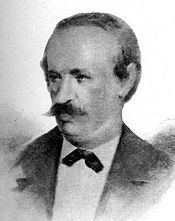
Carlo Vittadini
Encyclopedia

Physician
A physician is a health care provider who practices the profession of medicine, which is concerned with promoting, maintaining or restoring human health through the study, diagnosis, and treatment of disease, injury and other physical and mental impairments...
and mycologist
Mycology
Mycology is the branch of biology concerned with the study of fungi, including their genetic and biochemical properties, their taxonomy and their use to humans as a source for tinder, medicinals , food and entheogens, as well as their dangers, such as poisoning or...
.
Life
He studied in Milan and at the University of Pavia, where he attended the classes given by Giuseppe L. Moretti (1782–1853). He became a doctor of medicine in 1826 with a thesis entitled Tentamen mycologicum seu Amanitarum illustratio where he described 14 species of the genus AmanitaAmanita
The genus Amanita contains about 600 species of agarics including some of the most toxic known mushrooms found worldwide. This genus is responsible for approximately 95% of the fatalities resulting from mushroom poisoning, with the death cap accounting for about 50% on its own...
.
Outside of several publications on diseases of silkworms, he specialised in obstetrics
Obstetrics
Obstetrics is the medical specialty dealing with the care of all women's reproductive tracts and their children during pregnancy , childbirth and the postnatal period...
, working in Milan. He is the author of several important works on Italian mushroom species.
Works
- Monographia tuberacearum (Rusconi, Milan, 1831) - Describes 65 speciesSpeciesIn biology, a species is one of the basic units of biological classification and a taxonomic rank. A species is often defined as a group of organisms capable of interbreeding and producing fertile offspring. While in many cases this definition is adequate, more precise or differing measures are...
, of which 51 were new. * Descrizione dei funghi mangerecci più comuni dell'Italia e de'velenosi che possono co'medesimi confondersi (1835) - Describes 56 species, of which 15 were new. - Monographia Lycoperdineorum (1842) - Completes his 1831 study and describes 50 species, of which 23 were new.
- Trattato sui funghi mangerecci più conosciuti e paragoni con quelli velenosi con cui possono essere confusi (1844) - Written at the request of the Italian government, which was concerned over the number of incidents of mushrooms poisonings.
Taxa described
- Agaricus silvicolaAgaricus silvicolaAgaricus silvicola, also known as the Wood Mushroom is a species of Agaricus mushroom related to the button mushroom.- Description :...
- Amanita echinocephalaAmanita echinocephalaAmanita echinocephala is a large, whitish or ivory-coloured mushroom with a characteristic spiny, or warty-looking cap. It lives on chalky soils with beech trees, and appears earlier than most mushrooms of similar size in southern England...
(Vittad.) Quel. - The Shaggy parasolShaggy parasolThe Shaggy parasol is the common name for two closely related species of mushrooms, Chlorophyllum rhacodes and C. brunneum, found in North America and Europe .-Taxonomy:...
(Chlorophyllum rhacodes) - Rhizopogon vulgarisRhizopogon vulgarisRhizopogon vulgaris is an ectomycorrhizal fungus used as a soil inoculant in agriculture and horticulture....
- Several species of Tuber
- Amanita vittadiniiAmanita vittadiniiAmanita vittadinii, commonly known as the Vittadini's Lepidella , is a European saprophyte mushroom of the Amanita genus. It is believed that it is also one of the most ancient ones. This species is known to occur without accompanying woody plant symbionts...
(Moretti) Vitt. is named in his honour.

